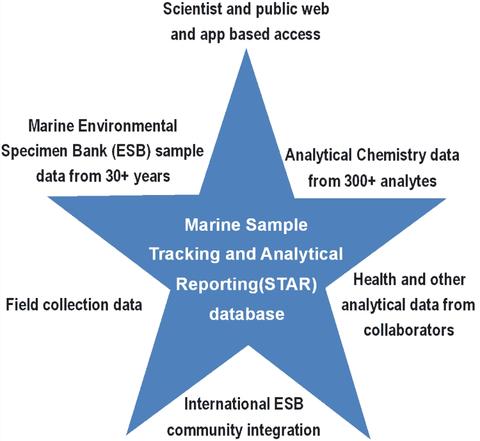Summary
The NIST Biorepository houses over 130,000 sample aliquots and the number continues to grow yearly. Fewer than 10% of these have been analyzed for environmental contaminants and health parameters by NIST and/or our collaborators, but this still corresponds to over 13,000 aliquots. Currently, data are not easily accessible; performing any data analysis outside specific project goals is extremely difficult. As more aliquots are analyzed, this issue will only become more complicated. STAR is in-progress to address this difficulty by developing a repository where analytical data will be centrally located and easily accessible by NIST researchers and our collaborators. Summaries will be publicly available through a web portal, stimulating additional avenues of inquiry and enabling global perspectives about environmental pollution and its effects.
Description

Illustration of the primary features of STAR software.
STAR (formerly known as Marine STAR) will develop a web-based interface to provide easy access to sample information from the NIST Biorepository. Information will include, but is not limited to, sample availability, chemical analysis status and results, and links to publications. Metadata associated with each sample and subsample, such as sample collection and status, is maintained by the NIST Biorepository in a relational database, Freezerworks Unlimited. These records will be linked with STAR to provide a complete history of each sample maintained in the biorepository from time of collection through the reporting of final analytical results. Providing information regarding samples collected and stored in the NIST Biorepository will enhance community engagement and more broadly connect information regarding environmental contaminants to stakeholders at all levels. Tying together the various types of data generated by NIST will enable powerful cross-disciplinary analyses of the state of environmental health. It is hoped this will spur intra- and extramural research questions at much broader scales than is currently possible, enabling community and ecosystem level investigations.
The scope for this project at the current time is strictly focused on information related directly to the NIST Biorepository. This includes:
- housing and retrieval of metrology data (including associated QA measurements and contextual information regarding how data were collected),
- streamlining sample metadata recording and storage (currently manually input and housed in FreezerWorks Unlimited),
- linking of metrology and sample metadata,
- generating data suitable to browser-based data exploration and visualization, and
- generating data reports in a manner to support statistical testing.
Care will be used in developing underlying data structures to enable application of the STAR framework more broadly.
In addition to sample history and status, data available through STAR will include metabolomic profiles, organic and inorganic contaminants, or health and biometric information to the extent feasible. Technical details regarding the structure of STAR, such as data source connectivity and security, are still being investigated.

